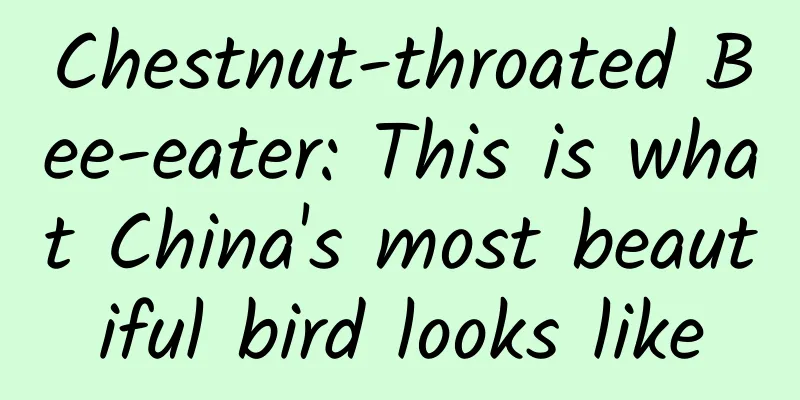Chestnut-throated Bee-eater: This is what China's most beautiful bird looks like

|
A bird's eye view of science Quanzhou Association for Science and Technology Quanzhou Bird Watching Society Editor's Note #千万IP创科普# The ecosystem is like a grand and exquisite symphony. In this song of nature, birds, with their agile posture, colorful feathers and pleasant singing, have become one of the most eye-catching notes. Popular science protects the green home. Quanzhou Association for Science and Technology, together with the Quanzhou Birdwatching Society, has launched a new special science column "Bird's Eye Science", which publishes bird science knowledge from time to time, selects and broadcasts student essays and paintings, guides the public to participate in ecological education, pays attention to bird protection and research, and jointly maintains ecological balance. There are carefully drawn bird paintings, which outline their beautiful contours with artistic brushstrokes; there are high-definition and realistic bird pictures, showing them flying, foraging, and playing in the forest, interpreting the vitality and agility of life. Let us walk into the bird world full of wonders and surprises and explore their unique value in the ecosystem. Chestnut-throated Bee-eater Photographer: Cui Qiyan Essay appreciation : "Everything has a spirit " 2023 Luojiang District Essay and Painting Competition Author: Wang Bolin Class 3, Grade 4, Luojiang Foreign Language School, Quanzhou, Fujian / Instructor: Lin Xiaojie My family lives near Luoyang Bridge, so observing egrets has become a daily routine. Walking on Luoyang Bridge, the morning breeze blows on my cheeks, and a cool feeling comes over me. All around are the rushing Luoyang River and the lush mangroves. The breeze blows, and the river ripples. Suddenly, a few white dots come into view, like white flowers blooming among the green trees. Why are the little flowers moving? I look closely, oh! It turns out to be a group of naughty egrets. "How many springs have the erythrina flowers bloomed, how many years have the East and West Towers faced each other, how many people have walked across the Luoyang Bridge, how many ships have sailed out of Quanzhou Bay, and now it's my turn to walk on the bridge..." After reading this article by Grandpa Yu Guangzhong, I closed the page, but those words are still lingering in my mind. With my curiosity and longing for Luoyang Bridge, accompanied by the sunset that has already dyed the sky light crimson, I walked along the Luoyang Bridge with my family, savoring the nature and beauty of Luoyang Bridge. When you reach the treetops, you can see green leaves swaying in the wind like boats, and beautiful flowers under the trees, red, yellow, and purple, blooming beautifully in the sun and dancing in the wind. In the distance, little bugs are playing and chasing freely among the flowers, which is really fun. ——Inscription One summer afternoon, I sat on the windowsill, enjoying the cool breeze, thinking about a question: "Does everything in the world have a soul?" I was so eager to figure this out that I didn't notice a little bird flapping its wings toward the window. It was a beautiful pigeon, with snow-white feathers, an orange beak, bright and watery eyes, and feet as bright as red agate. In the sun, it was like an angel descending from the sky, with its feathers gleaming with dazzling light. The little bird seemed to be interested in the world on the window and didn't want to leave. Looking at it, I felt pity for it and took out some bread crumbs for it to eat. After the bird had eaten and drunk enough, it fluttered its wings lightly and flew away. Looking at its back as it went away, I couldn't help but feel a little reluctant. After a few days, the question seemed to be forgotten, but the story of the bird often echoed in my mind. Every day I would prepare some food and put it on the windowsill, waiting for the bird to come. Gradually, it was no longer just a bird flying by, but became a friend in front of my window. When I took out the food, it would look at me with bright eyes and flap the air with its soft wings, as if to say to me: "Thank you!" We established a tacit understanding. One day, when I opened the window, I found a beautiful flower hanging on it. I was stunned, and my heart was full of doubts: "What's going on? Who sent the flower?" I looked up and saw a familiar figure outside the window. It turned out to be the dove of peace. It expressed its gratitude in its own way, and I was so moved that I almost burst into tears. Finally, I understood the meaning of "everything has a deep spirituality" and I also understood that we should cherish life and respect every existence. Through my encounter with the bird, I answered the questions in my heart and gained more. I learned the wisdom of harmonious coexistence between man and nature. Every help and care in life is a kind of beauty. We should feel it with our hearts and cherish it with actions. Let us work together to make the world full of love and beauty! This experience has passed, but it is like a glass of timeless wine in my memory, exuding fragrance all the time. For me, it will never be forgotten. Science Extension: Chestnut-throated Bee-eater Scientific Name: Merops philippinus Meliidae The chestnut-throated bee-eater is a bird of the family Meligomorpha and is a national Class II key protected wild animal . The distinctive features of the chestnut-throated bee-eater are chestnut-red throat with black eye stripes, green back and blue tail, and orange-yellow underwing feathers can be seen when flying . Adult chestnut-throated bee-eaters are green all over, with a prominent blue tail, a narrow blue spot on the face and black eye stripes, chestnut-red to brown-yellow throat and cheeks, green abdomen, and blue undertail feathers. The iris is deep red, and males and females look similar. Juveniles are lighter in color, with brown-yellow throats and shorter tails. They do not have the long tail feathers of adults, and their heads and body edges are white. The chestnut-throated bee-eater mainly preys on insects of the orders Hymenoptera, Odonata, Lepidoptera, Diptera, Orthoptera, Coleoptera, and Homoptera, with the first three orders being the main prey, and bees are particularly preferred. It inhabits a variety of open areas near water, such as mangroves, tidal estuaries, woodland edges, forest clearings, lakeshores, river valleys, plantations, farmlands, rice fields, urban gardens, etc. |
>>: Is it true that crying can eliminate toxins from the body?
Recommend
How to operate content well and create phenomenal products
In my past work experience, I have always been th...
What are the conditions for opening a Douyin store? What are the specific activation steps?
This article mainly introduces the conditions for...
Not only are these foods not "toxic" after sprouting, they may also have higher nutritional value. Don't waste them!
This article was reviewed by Zhang Zhaomin, Maste...
AI meets obsessive-compulsive disorder, solving the rift between the brain and emotions
As the New Year is coming to an end, many people ...
Which investment projects are the most profitable in 2020? How to find highly profitable projects in 2021?
Today I will tell you how to explore highly profi...
18 ways to monetize short videos
18 ways to monetize short videos The course is 60...
How to design a B-side button? Check out this expert summary!
In the B-side interface, buttons are the most bas...
With 100,000 employees laid off, how many European car manufacturers will be able to pay N+6 compensation like Porsche did in the future?
No one in the European auto industry will have an...
What is the set date for the WeChat Pay merchant platform? How can I refund on it?
It can be said that the emergence of the WeChat P...
Wild watermelon seedlings are neither watermelons nor seedlings.
Speaking of wild watermelon seedlings Hibiscus tr...
Why should we protect rare species?
A penguin wanders around the empty parking lot of...
SEM | Click is a technology, conversion is an art, why do we say that?
Over the past few decades, the rapid and innovati...
In Poyang Lake, rotifers create 133 trillion plastic particles every day
The total number of nanoplastic particles produce...
What condiments did the ancient people who only ate dry food use in their cooking?
Chinese people say that food has five flavors, na...
For an inventory H5, what are the factors that cause it to go viral?
While people were still immersed in the joy of a ...









